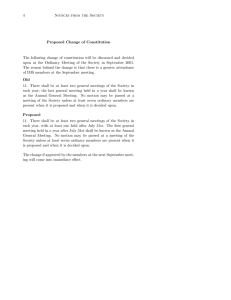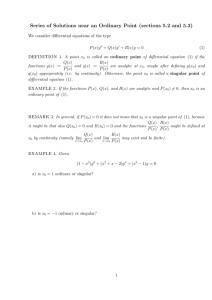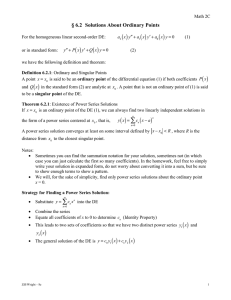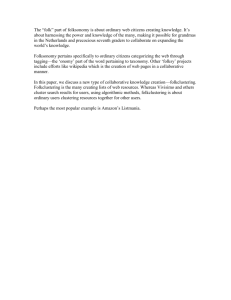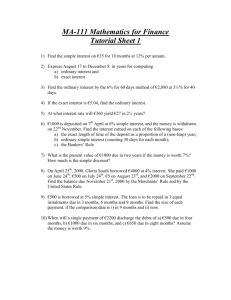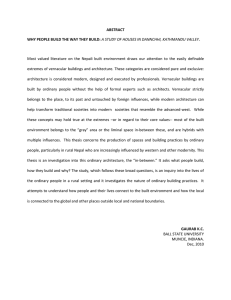Lectures 4,5 Ordinary Points and Singular Points Chapter 4 4.1
advertisement
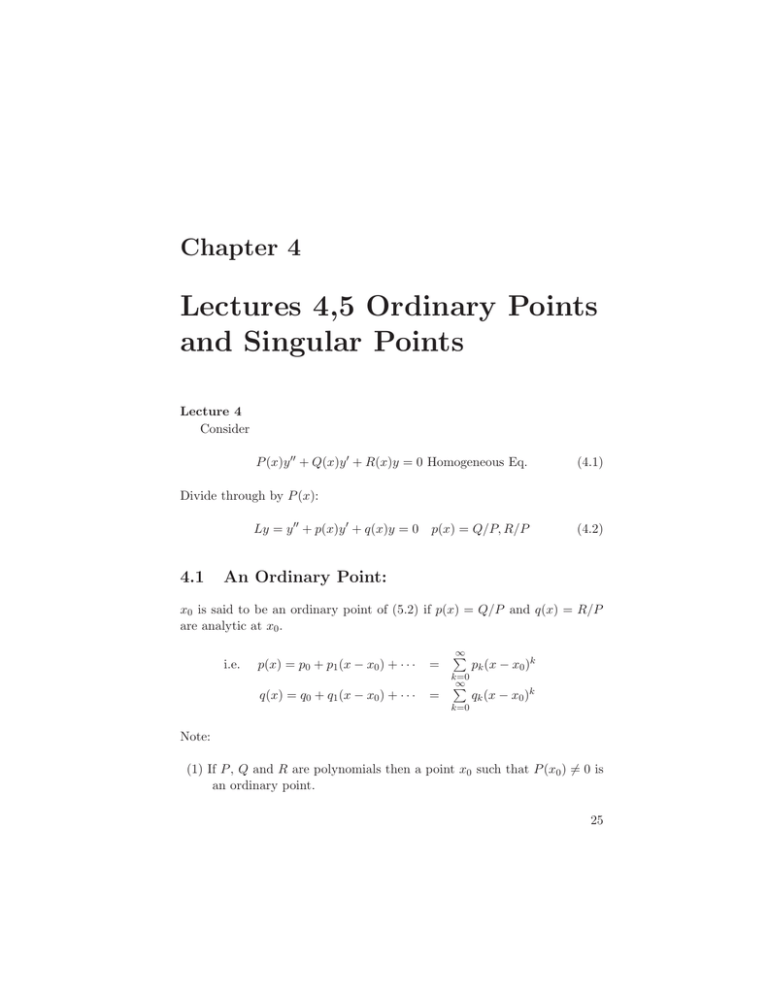
Chapter 4
Lectures 4,5 Ordinary Points
and Singular Points
Lecture 4
Consider
P (x)y + Q(x)y + R(x)y = 0 Homogeneous Eq.
(4.1)
Divide through by P (x):
Ly = y + p(x)y + q(x)y = 0 p(x) = Q/P, R/P
4.1
(4.2)
An Ordinary Point:
x0 is said to be an ordinary point of (5.2) if p(x) = Q/P and q(x) = R/P
are analytic at x0 .
i.e.
p(x) = p0 + p1 (x − x0 ) + · · ·
=
q(x) = q0 + q1 (x − x0 ) + · · ·
=
∞
k=0
∞
k=0
pk (x − x0 )k
qk (x − x0 )k
Note:
(1) If P , Q and R are polynomials then a point x0 such that P (x0 ) = 0 is
an ordinary point.
25
Lectures 4,5 Ordinary Points and Singular Points
(2) If x0 = 0 is an ordinary point then we assume
y =
0 = Ly =
∞
n=0
∞
n
cn x
, yn
∞
=
n−1
cn nx
n=1
cn n(n − 1)xn−2 +
n=2
+
∞
n
qn x
n=0
, yn
cn n(n − 1)xn−2
n=2
∞
∞
pn xn
n=0
∞
=
∞
ncn xn−1
(4.3)
n=1
n
cn x
n=0
∞
(m + 2)(m + 1)cm+2 + p0 (m + 1)cm+1 + · · · + pm c1
m=0
+ (q0 cm + · · · + qm c0 )} xm = 0
(4.4)
yields a non-degenerate recursion for the cm .
At an ordinary point x0 we can obtain two linearly independent solutions by power series expansion.
About x0 :
y(x) =
∞
cn (x − x0 )n .
(4.5)
n=0
(3) The radius of convergence of (4.5) is at least as large as the radius of
convergence of each of the series p(x) = Q/P q(x) = R/P .
i.e. up to the closest singularity to x0 .
4.2
A Singular Point:
If p(x) or q(x) are not analytic at x0 , then x0 is said to be a singular point
of (4.2). For example if P , Q and R are polynomials and P (x0 ) = 0 and
Q(x0 ) = 0 or R(x0 ) = 0 then x0 is a singular point.
EG:
(4.6)
(x − 1)y + y = 0
x = 0 is an ordinary point.
x = 1 is a singular point.
Expand around the ordinary point
y(x) =
∞
n=0
26
cn xn ,
y =
∞
n=1
ncn xn−1 ,
y =
∞
n=2
cn n(n − 1)xn−2
(4.7)
4.2. A SINGULAR POINT:
(x − 1)
−
∞
∞
cn n(n − 1)xn−2 +
n=2
cn n(n − 1)xn−2 +
n=2
∞
∞
ncn xn−1 = 0
n=1
cn {n(n − 1) + n} xn−1 + c1 = 0
(4.8)
n=2
m−1=n−2⇒m=n−1 n=2⇒m=1 n=m+1
∞
−cm+1 (m + 1)m + cm m2 xm−1 = 0
−c2 · 2 · 1 + c1 +
m=2
c0 Arbitrary:
c1
m
cm m ≥ 2 c2 =
m+1
2
2
c1
3
c1
c1
c2 =
c4 = c3 =
. . . cn =
c3 =
3
3
4
4
n
∞
n
x
.
Therefore y(x) = c0 + c1
n
cm+1 =
(4.9)
n=1
Recall
1
= 1 + x + x2 + · · ·
1−x
y(x) = A + B ln |x − 1|
x2 x3
1
dx = − ln |1 − x| = x +
+
+ ···
1−x
2
3
(4.10)
But (4.6) is also an Euler Equation:
y = (x − 1)r ⇒ r(r − 1) + r = r2 = 0 r = 0, 0.
y(x) = A + B ln(x − 1)
(4.11)
27
